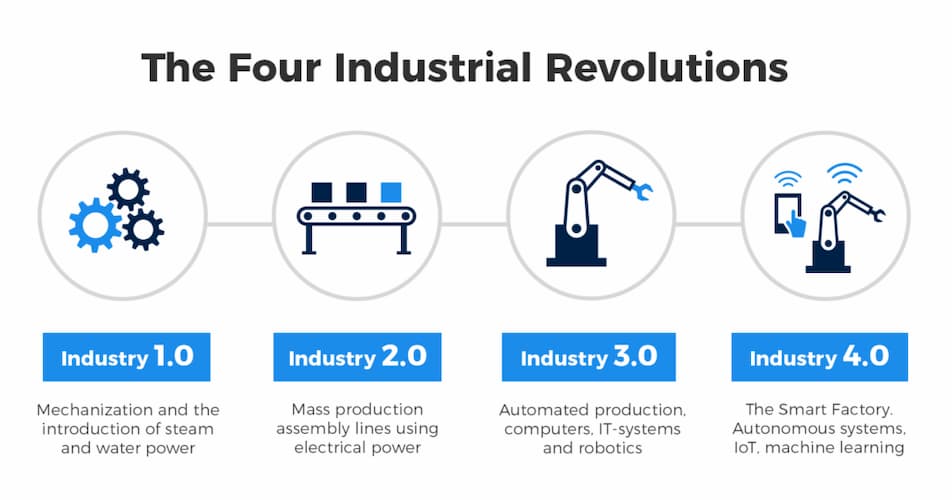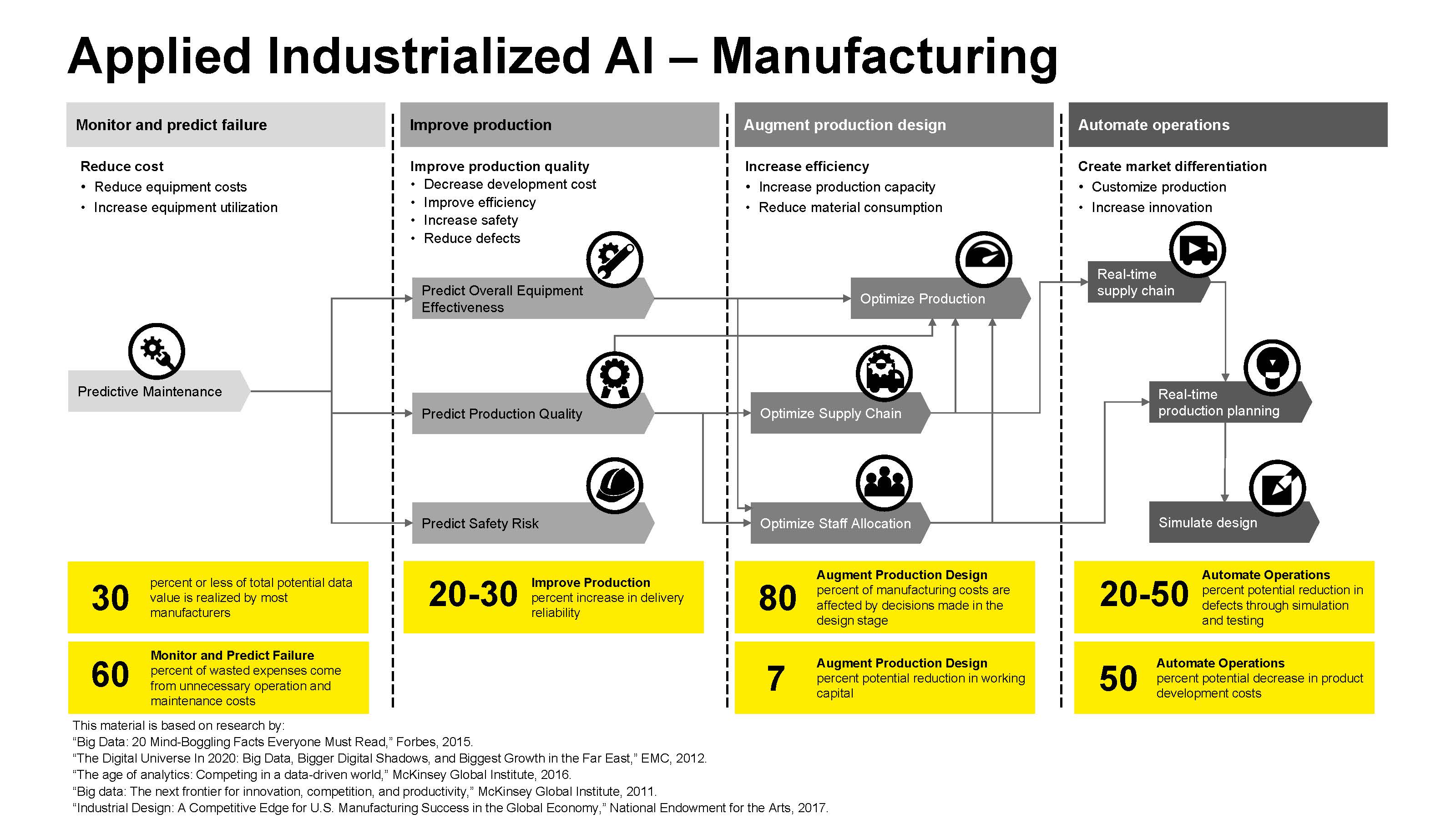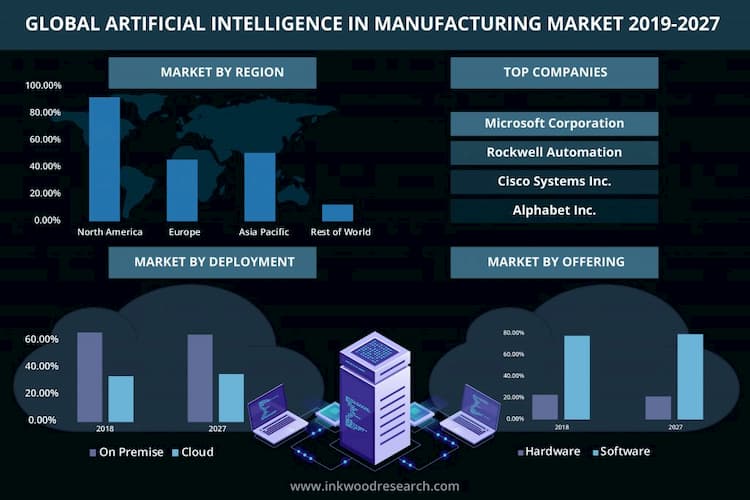How is AI Used in Manufacturing Industry Now?
Manufacturing is one of the main industries that uses Artificial Intelligence and Machine Learning technologies to its fullest potential. Smart Factories, also known as Smart Factories 4.0, have major cuts in unexpected downtime and better design of products as well as improved efficiency and transition times, overall product quality, and worker safety. Artificial Intelligence is the heart of Industry 4.0, delivering more productivity while staying environmentally friendly.
Siemens, GE, Fanuc, Kuka, Bosch, Microsoft, and NVIDIA, among other industry giants. are already heavily investing in manufacturing AI with Machine Learning approaches to boost every part of manufacturing. TrendForce estimates that Smart Manufacturing (the blend of industrial AI and IoT) will expand massively in the next three to five years. By 2020, the global smart manufacturing market will be valued at over $320 billion, with a compound annual rate of growth at 12.5%. In 2015, the number of functioning industrial robots in factories was 1.6 million; in 2019, the number was expected to grow to 2.6 million, according to the International Federation of Robotics. According to Google Trends, people were searching for “AI in Manufacturing” in 2019 more than ever before.
Let’s start by explaining how exactly AI/ML in modern manufacturing can transform the industry.
Don't have time to read?
Book a free meeting with our experts to discover how we can help you.
Book a MeetingHow Can AI Help Manufacturing?
Smart Maintenance
Being a very important part of every asset-reliant production operation, maintenance of equipment is one of the biggest expenses in the manufacturing industry — unplanned downtime cost plants and factories nearly $50 billion, 42% of that was because of asset failure.
That’s why predictive maintenance became a vital solution that will help save an enormous amount of money. Complex AI algorithms like neural networks and Machine Learning are generating trustworthy predictions regarding the status of assets and machinery. The Remaining Useful Life (RUL) of equipment becomes significantly longer. If something needs to be repaired or replaced, technicians will know beforehand and even will know which methods to use to fix the issue.
Better Product Development
Generative design is the method that allows putting a detailed brief created by humans into an AI algorithm. The information in the brief can contain different parameters like available production resources, budget, and time. The algorithm examines all possible variations and generates a few optimal solutions. This set of solutions can be evaluated by pre-trained deep learning models, which can add more insights and pick certain options. You can go through this process as many times as you want to settle on the perfect one. Artificial Intelligence is completely objective without any unproven assumptions unlike humans can have.
Quality Improvement
In the modern world of short deadlines and the increased level of complexity of products, it becomes even harder to meet the highest standards and regulations in terms of quality. Customers expect impeccable products. Also, product defects can cause recalls, which massively damages the reputation of the company and its brand. AI can alert companies to problems in the production line that can result in quality issues. These faults could be major or subtle, but they all influence the overall level of production and could be eliminated in the early stages.
Machine vision, for example, is an AI solution that uses high-resolution cameras to monitor defects way better than a human can. It could be combined with a Cloud-based data processing framework that generates an automatic response. Also, manufacturers can obtain data on the performance of their products when they hit the market to make better strategic decisions in the future.
Market Adaptation
AI and ML are already an essential element of Factory 4.0, but they also can improve supply chains, making them interactive to changes on the market beforehand. Thus, managers can improve their strategic vision by relying on AI suggestions. Estimates are generated by AI based on linking together a number of factors such as political situations, weather, consumer behavior, and the status of the economy. Staff, inventory, and the supply of materials could be calculated according to predictions.
The biggest companies around the globe are already utilizing Artificial Intelligence and Machine Learning in manufacturing and investing millions in its development. Here are some of the most prominent examples of companies using it.

Applications of ML in Manufacturing
Siemens
The German conglomerate claims that its practical experience in industrial AI for manufacturing already boosted the development and application of the technology. For decades, they leveraged neural networks for monitoring steel factories as well as improving their performance. Over the last 10 years, they invested over $10 billion in the acquisition of software companies.
In 2016 Siemens presented Mindsphere, a smart Cloud that enables manufacturers to monitor machine fleets around the globe. They added IBM’s Watson Analytics to the functions offered by the service the same year. The purpose of this solution is to grab every parameter in the manufacturing process from development to delivery and find issues and the ways to solve them.
Siemens uses a neural network-based AI in their gas turbines. Over 500 sensors monitor various parameters, and the system learns and makes decisions on adjusting fuel values for the most efficient performance.
Siemens also offers Click2Make – a product that set a goal to make mass customization a reality. When companies have a complete understanding of their resources and have cutting-edge robots, it will be possible. To illustrate this, imagine a company that needs to deliver a limited edition of chairs. All the company has to do is upload the design, then the systems would provide this information to the factories that have all the necessary tools to build them. After the factory starts production, the company’s management can seek potential buyers in real-time. This significantly boosts the path from design to delivery.
General Electric
One of the biggest companies on the planet, General Electric makes everything from home appliances to massive industrial machinery. They have over 500 plants worldwide, but they have only just begun to make them smart.
Brilliant Manufacturing Suite is an attempt from GE to track and process everything in every aspect of manufacturing to find all possible problems and failures. Their first Brilliant Factory in India received $200 million in investments and raised the effectiveness rate of the facility by 18%, thanks to this solution. GE’s Brilliant Manufacturing Suite aims to connect all elements of manufacturing, such as design, engineering, or distribution, into one global smart system that is scalable. It even has its own Industrial IoT platform Predix. This platform uses sensors to monitor all aspects of the manufacturing process and the performance of sophisticated equipment. Predix has deep-learning capabilities that can process all that information and come up with actionable insights. GE already invested over $1 billion in this system, and by 2020 Predix will process over 1 million terabytes of information a day.
At the moment, General Electric runs seven Brilliant Factories with the Predix system; all have seen positive improvements in production.
Fanuc
This company from Japan implements AI to make robots smarter. In fact, it is a leader in industrial robotics by integrating deep learning into robots. Fanuc collaborated with Rockwell and Cisco to introduce the FANUC Intelligent Edge Link and Drive (FIELD), an IoT platform for the manufacturing industry. The partnership with NVIDIA resulted in using Fanuc’s AI chips for the factories of the future. The usage of deep reinforcement learning led to the ability of some industrial robots to train themselves. FANUC and NVIDIA aim to enable multiple robots to learn simultaneously. If robots can learn together, it will be faster for each of them individually. In the future, robots will be able to share their skills with each other — saving time in the manufacturing processes in the Smart Factory.

Big Data in Manufacturing: 10 Use Cases
Years ago, Henry Ford pioneered a smart way to optimize manufacturing – he paid one of the repair teams for the time spent in the recreational room when everything worked perfectly fine. As a result, the workers became more productive while downtime decreased.
These days, such methods are not enough to stay competitive – smart ideas should be combined with groundbreaking technology. Big Data is one of those technologies that can help manufacturers optimize their processes. Companies are collaborating with Big Data consultants to plan strategies for the adoption of higher technology. If you are still questioning this move, the following use cases are for you. We hope it will change your mind!
The extracting process improved
A precious metal manufacturer once experienced an ore grade decline. The obvious way to solve this problem was to make the metal extracting and refining processes better. Leveraging data from the sensors, the Big Data solution detected the factors that influenced the output process. The most defining factor turned out to be the level of oxygen. After learning this information, the team tweaked the leaching process — which increased yield by 3.7%. The ore grade deterioration rate was 20%, but a Big Data analysis eliminated it and brought an additional $10-$20 million annually to the manufacturer.
Perfecting the chemical yield
A top European manufacturer of chemicals set a goal to improve yield. Their Big Data solution used sensor data to analyze every factor that impacted production output. Among the factors were: carbon dioxide flow, coolant pressures, quantities, temperatures. Those rates were compared to each other. Carbon dioxide flow rates proved to be the defining factor. With a moderate change in parameters, the waste of raw materials was lowered by 20%, energy costs decreased by 15%, and yield was massively improved.
Improving vaccine yield
A pharmaceutical giant was looking for a way to boost the yield of their vaccines with a Big Data solution. By analyzing sensor data from the equipment, revealing the interdependencies, and comparing different parameters, the top essential factors were found, reviewed, and adjusted. This resulted in a 50% vaccine yield improvement and $5-$10 million of additional revenue a year for one substance.
Optimizing sugar-sweet
A large sugar manufacturer suffered from high humidity levels and poor quality of raw materials, which influenced the taste of sugar. A Big Data solution quickly improved the quality of the product and created a unified sugar standard despite the external factors. The initial problem was solved, production costs lowered, workloads simplified, and customer satisfaction improved.
Vehicle quality assurance
BMW has been using Big Data for detecting flaws in their prototypes since 2014. Data was gathered from sensors installed on prototypes in testing, as well as from cars in use. A Big Data analysis detected weak points and errors in prototypes and cars that were already sold. Engineers had an opportunity to eliminate vulnerabilities in prototypes before mass production, which lowered the number of future recalls. By doing this, BMW saved lives, built brand value, and reduced warranty costs.
Designing a jet engine
Rolls-Royce is a famous user of Big Data technology, implementing it in the manufacturing of new aircraft engines. Big Data solutions take control at the design stage, analyzing terabytes of information during a simulation. The company knows the strong sides and weaknesses of a model long before it is scheduled for production, which lowers defect-related costs, improves the quality of the product, and ultimately saves lives.
Expanding an enterprise based on data
Big Data solutions can answer the question of whether it is profitable to open a new factory in a certain location. Predictive models and what-if scenarios built on historical data can not only help with that but also with forecasting the demand for new products or entering new markets.
Access to raw materials
An enterprise was looking for better ways to deliver raw materials and reduce the costs of supply chain failures. Based on suppliers’ route details, weather, traffic data, and other factors, a Big Data tool integrated with the MRP leveraged the predictive analytics to figure out possible delays. Now the enterprise runs the production process without interruptions and at significantly lower downtime costs.
Predictive maintenance
Factory equipment at Intel transfers data gathered by the Internet of Things right into its Big Data solution. Pattern recognition, visualization, and fault detection are achieved by doing this. Engineers there clearly see the tendencies and know what immediate actions should be taken to prevent serious breakdowns. This predictive maintenance solution reduced reaction time from nearly four hours to half of a minute, and significantly reduced costs. This saved up to $100 million in 2017.
Hull cleaning
A client asked Caterpillar Marine to analyze how hull cleaning could impact the performance of the fleet. The company used its Big Data solution integrated with its Asset Intelligence platform and made a sensor-based analysis on ships running with and without cleaned hulls. After certain correlations were discovered, Caterpillar Marine advised cleaning hulls every six months rather than every two years. This enabled the most efficient exploitation of their ships as well as improved brand image and client satisfaction.

Deep Learning Manufacturing
Powered by cutting-edge technologies like Big Data and IoT in manufacturing, smart facilities are generating manufacturing intelligence that impacts an entire organization. Today, the manufacturing industry can access a once-unimaginable amount of sensory data that contains multiple formats, structures, and semantics. On the way from sensory data to actual manufacturing intelligence, deep learning received a lot of attention as the leading innovation in computational intelligence. Deep learning techniques enable people to automatically learn from data, detect patterns, and make decisions. We can distinguish different levels of data analytics, including predictive analytics, prescriptive analytics, diagnostic analytics, and descriptive analytics.
- Predictive analytics uses statistical models to make forecasts about the possibilities of future production and equipment degradation.
- Prescriptive analytics offers multiple scenarios to take action.
- Diagnostic analytics is aimed at reporting the reason for equipment failure.
- Descriptive analytics is concluding what happens at the moment by analyzing operational parameters, environment, and conditions of the product.
The advanced analytics gained from deep learning transform manufacturing into high-performance smart facilities. The benefits are many, including lowering operational costs, adjusting to customer demand, boosting productivity, possible customer demand forecasting, reducing downtime, obtaining better visibility, and getting more value from the operations in general.
Conclusion on AI in Manufacturing
For years robotics, advanced analytics, and automation has been a major part of the manufacturing industry. The increasing scale of adoption of AI in manufacturing seems more like an evolution, rather than an industry disruption. Technology is already here and more massive implementation is a matter of time. According to McKinsey, by 2025 smart factories will generate $37 trillion.
Ready to speed up your Software Development?
Explore the solutions we offer to see how we can assist you!
Schedule a Call